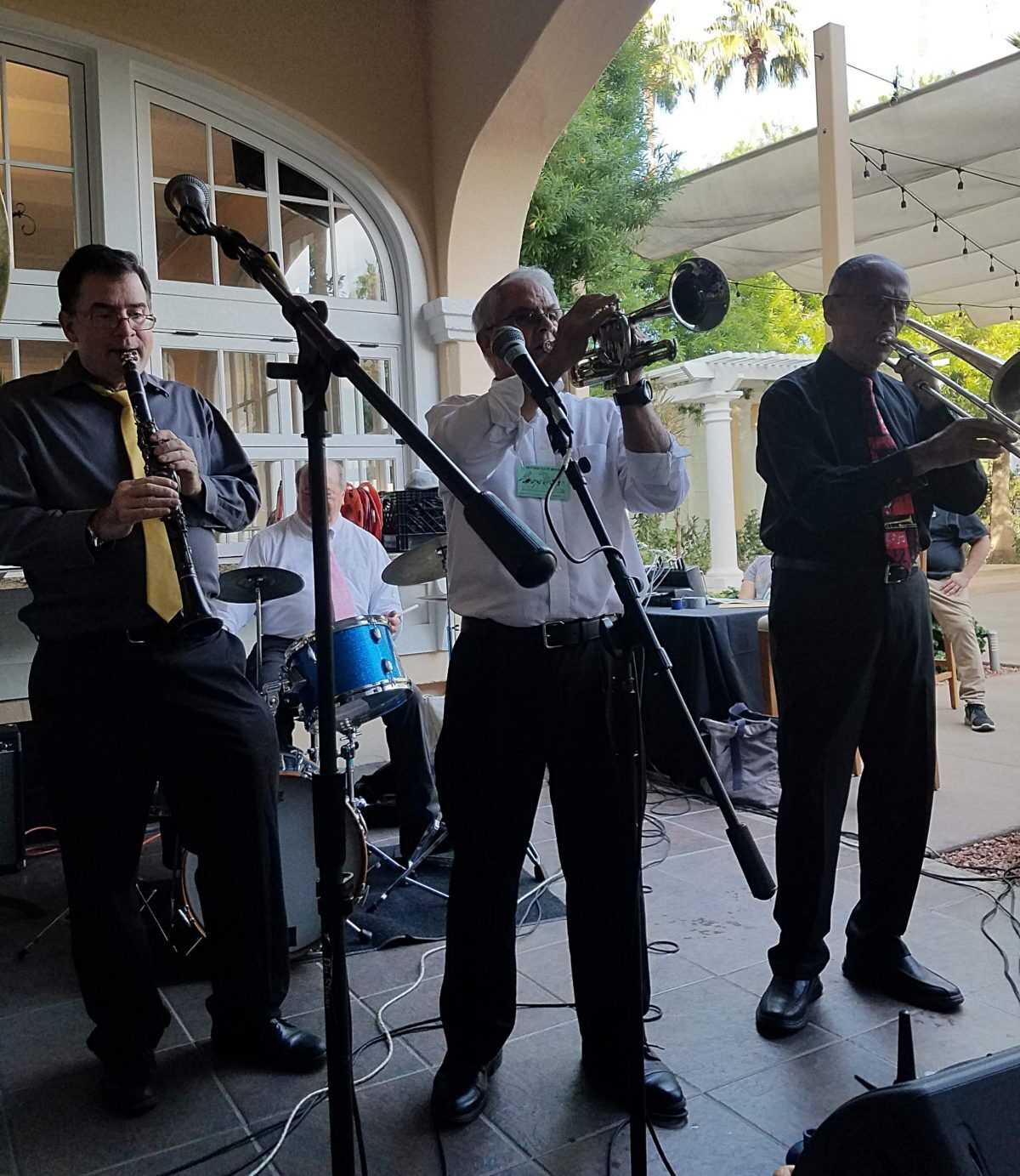After eight long months of cancellations and dark venues, there is at last a glimmer of light at the end of the proverbial tunnel. With all necessary precautionary measures in place and barring any unforeseen disruptions, the 31st annual Arizona Classic Jazz Festival will present live performances of more than a dozen groups the weekend of November 5-8 at the Crowne Plaza San Marcos Golf Resort in Chandler, AZ.
“I am still receiving reservations because jazz fans are so anxious to hear live jazz once again,” according to festival director Helen Daley. “I have been working closely with the hotel and local health officials, and we will have a test run at our pre-festival party in October. We have 550 masks and ample sanitizers available along with 2,000 pairs of gloves which the dancers will change after each set.”
“We will have four venues, one of which is outside under cover. Seating will be spaced according to the regulations at the time. We know from previous experience that only about one-third of the attendees are in the venues at any one time. There will be a 20-minute break between sets instead of 15 minutes so that there will be just one band on the bandstand at any time. Our daily schedule will end at 10 pm Friday and Saturday, instead of close to midnight. Two of our originally-scheduled bands opted not to make the trip to Arizona, but we have booked suitable replacements.”
Prospects for 2021
Operating at considerably reduced capacity would appear to be the best chance for resumption of live theatrical and musical events in the early part of 2021. An example of how this would work is illustrated by a recent announcement from Lakeshore Music, an independent production company that has presented an annual jazz series at the Tempe Center for the Performing Arts for the past 12 years.
Acknowledging that everything is an experiment for at least the next year, the announcement stated, “We will have been on live music lockdown for over 10 months when we will resume the balance of our 2020-2021 series on January 23 featuring Tierney Sutton and with our audience capacity reduced by 75%, or 150 seats. We will have only 50 to 60 socially-distanced seats available, which we will sell as a subscription package for $200 for the six concerts.”
“No single concert tickets will be sold, there will be no reserved seats, and we will need to sell every single season ticket to squeak by. We will provide a live streaming link for those who wish to remain at home and view the shows on their smart TV.”
Venues and presenters throughout the world, large and small, are faced with the same realities. New York City’s Metropolitan Museum of Art and Museum of Modern Art are admitting only 25% of their regular capacity. The Houston Symphony reopened its 2,900-seat concert hall, but will play for only 150 people.
The Dallas Symphony is offering programs by “smaller orchestral ensembles” to be performed for audiences of no more than 75 in its 2,062-seat hall. Ballet companies have scrapped The Nutcracker, the cash cow that pays their bills for the rest of the year, and museums are leaving up the exhibitions that were on display in March.
Streaming
When COVID-19 put a halt to live concerts and touring, many musicians took to creating virtual concerts from their homes or in a nearby park. As musicians have become more comfortable with these virtual concerts and found ways to generate some income, better production, improved visuals, and enhanced viewer experience have come into play. It’s been great for fans, but has done little to replace the nearly $30 billion in revenue that live music events were expected to generate in 2020.
Singer-songwriter Melissa Etheridge, for example, streams five days a week on her website, charging $50 a month or $10 per show. David Isenberg, who has produced over 100 house concerts from his home in Woods Hole, Massachusetts, since 2006, now is promoting on-line concerts for which he charges $20 (or whatever an individual can afford), with all the funds collected going to the musicians. With many viewers contributing more than the minimum, he reports some concerts have generated revenue between $600 and up into the low four-figures.
Liability Issues

The current outlook is that live concerts are not expected to return in any significant numbers until a vaccine is available and broadly distributed, which may be well into 2021, according to the most optimistic projections. There have been a few promoters that have tested the waters and been faced with a perplexing problem: If a fan catches the virus while attending a socially-distanced concert or show, who is legally liable?
Unless Congress provides some federal liability protection in the next coronavirus relief package, concert and theatrical performances, which depend on mass gatherings, will be subject to a patchwork of state-by-state standards and requirements. Do promoters have insurance that protects them from such potential lawsuits and what can they do to reduce their legal risks? Fans also bear some responsibility because they have made the choice to attend that event and assume some risk, even if the event has compiled with all the rules and not been grossly negligent.
Like so much that has transpired over recent months, we continue to traverse through uncharted waters.
Lew Shaw started writing about music as the publicist for the famous Berkshire Music Barn in the 1960s. He joined the West Coast Rag in 1989 and has been a guiding light to this paper through the two name changes since then as we grew to become The Syncopated Times. 47 of his profiles of today's top musicians are collected in Jazz Beat: Notes on Classic Jazz.Volume two, Jazz Beat Encore: More Notes on Classic Jazz contains 43 more! Lew taps his extensive network of connections and friends throughout the traditional jazz world to bring us his Jazz Jottings column every month.






















